IPv6, a protocol developed in the late 1990s to address the anticipated Internet address exhaustion crisis, exists in a paradoxical state. For some, while its adoption might have taken longer than expected, it represents a success story - steadily expanding in deployment and enabling more users and devices to connect to the Internet. For others, it appears stalled and increasingly irrelevant, overshadowed by the enduring dominance of IPv4-based solutions, especially as the predicted exhaustion crisis never fully materialised. Much like Schrödinger’s famous cat, its status - alive or dead - remains uncertain until the box is opened and its true state revealed.
The Internet is a global network of networks, interconnected through open standards that enable interoperability, registration services that ensure uniqueness, and governance structures - such as the Internet Engineering Task Force (IETF), the Regional Internet Registries (RIRs) and the Internet Corporation for Assigned Names and Numbers (ICANN) - that develop protocols, policies, and frameworks for coordination and accountability. It serves as the foundation of the digital era we live in today.
To understand IPv6’s paradoxical state - both thriving and struggling - it is essential to understand the Internet’s foundational architecture. At its core, the Internet relies on a finite pool of unique IP addresses, which enable seamless communication between billions of users and devices.
IPv6 was developed to ensure the Internet’s scalability as IPv4 addresses neared exhaustion, providing an almost infinite address space to support the growing number of devices and users connecting to the Internet. However, its adoption has been anything but straightforward, with progress varying significantly across regions, industries, and use cases.
This isn't just a technical issue - it's about preserving the Internet as a global platform for permissionless innovation. By eliminating address scarcity, IPv6’s vast address space facilitates the development of new applications, services, and devices, ensuring the Internet remains open for future innovation.
How the IPv6 Cat got stuck
One key reason for this uneven progress is the extension of IPv4’s lifespan through interim technologies like Network Address Translation (NAT) and IPv4 address transfers.
- Network Address Translation (NAT) allows multiple devices within a private network (like a home Wi-Fi) to share a single public IP address (the address visible to the Internet). This helps stretch the limited supply of IPv4 addresses, but it also brings added costs and complexities.
- IPv4 address transfers—facilitated by policies developed through Regional Internet Registries' (RIR) governance structures—have enabled organisations to temporarily or permanently transfer their IPv4 addresses to meet demand.
While these measures have provided short-term relief by reallocating address space, they have also created a secondary market for IPv4 addresses, often making them expensive and less accessible to smaller organisations or developing regions. Collectively, these measures have delayed the urgency to transition to IPv6.
Adding to these challenges is the inconsistent IPv6-readiness of vendors and application developers - including those producing IPTV platforms, billing software, and other Value Added Services (VAS) systems.
- While some vendors have fully embraced IPv6, achieving feature parity with IPv4 and seamlessly integrating it into their products, others lag significantly behind. For certain vendors, IPv6 support is entirely absent from their development roadmaps. This inconsistency creates significant adoption gaps. Organisations relying on vendors who have not prioritised IPv6 face substantial barriers, even if they are willing to invest in the transition. These gaps in the vendor ecosystem amplify the sense of IPv6’s mixed reality, where its viability depends heavily on the readiness and commitment of industry players.
- Similarly, value-added service providers and application builders often deprioritise IPv6. Many legacy systems and applications remain IPv4-only, hindering end-to-end IPv6 deployments. This forces network operators to maintain dual-stack configurations or rely on IPv4-to-IPv6 protocol translations. These transition mechanisms, while essential for interoperability, increase costs and complexity, further discouraging adoption.
The paradox of transition mechanisms
Since IPv4 and IPv6 are incompatible protocols, the coexistence of IPv4-only and IPv6-only networks poses a significant risk of technical Internet fragmentation. This disruption could impact global connectivity, businesses, services, and end-users who rely on seamless interoperability.
Transition mechanisms, such as dual-stack configurations and technologies like 464XLAT (used in mobile networks for IPv4-to-IPv6 translation) and MAP-T (a mechanism for managing address sharing) play a vital role. They provide a practical pathway for networks and applications to adopt IPv6 without losing connectivity to IPv4-based networks, content and services. This interoperability safeguards the seamless experience users expect from the Internet, even as different regions and industries progress at varying speeds in their transition to IPv6.
However, while these mechanisms are indispensable for maintaining a global and operational Internet during the transition, they also create unintended consequences. By allowing IPv4 to persist alongside IPv6, they reduce the sense of urgency to fully migrate to IPv6. This extended coexistence slows the pace of IPv6 adoption and perpetuates the impression that the IPv6 Cat is stuck and struggling to stay alive.
National efforts to untangle the IPv6 Cat
While technological solutions like transition mechanisms address immediate challenges, national strategies have been instrumental in shaping the trajectory of IPv6 adoption.
National IPv6 roadmaps
Over the years, many governments have introduced national IPv6 roadmaps with varying degrees of success. Some countries, such as Germany and the Kingdom of Saudi Arabia, have taken pragmatic approaches that yielded remarkable results. These governments developed structured delivery plans with clear key performance indicators (KPIs) and milestones. By collaborating closely with the technical community, they ensured their plans were regularly reviewed and adjusted to align with on-the-ground realities. Maintaining a steady, realistic pace and adapting to evolving circumstances have allowed these nations to rank among the highest globally in IPv6 adoption, as measured by metrics such as end-user adoption rates.
In contrast, other governments have struggled with overly ambitious, theoretical roadmaps that failed to account for the technical realities of deploying IPv6. Often developed by external consultants and turned into political decisions without sufficient technical community input, these plans eroded credibility as deadlines passed unmet, fostering skepticism and reducing the perceived urgency of IPv6 adoption.
Top-down mandates and standards
In response to the lack of progress and mounting pressure to meet digital agenda goals, some governments have turned to mandating IPv6-only deployments on their infrastructure as a way to enforce compliance and accelerate adoption. These mandates are often seen as a direct attempt to address the shortcomings of traditional roadmaps by bypassing voluntary industry efforts. However, while well-intended, such mandates can create additional problems due to the rapid pace of technological evolution that often outpaces the ability of policy to adapt, making top-down approaches risky and unrecommended.
Another example of a top-down approach is the development of proprietary standards like IPv6+, which aims to support emerging applications like 5G, IoT, and smart cities but diverges from the open standards maintained by the Internet Engineering Task Force (IETF). Branded under various names, including "Green IP", "New IP" and "Network 2030", IPv6+ has raised concerns about interoperability and the potential fragmentation of global Internet protocols.
Proprietary standards like IPv6+, unlike the open standards developed by the IETF, undermine the Internet’s role as a platform for general-purpose connectivity. Open standards enable permissionless innovation and seamless interoperability across thousands of networks, regardless of their underlying technologies or vendors. This fundamental principle is threatened when governments or intergovernmental organisations overstep their mandates, disregarding the established governance structures of the Internet, such as the IETF, Regional Internet Registries, and ICANN, by attempting to develop their own standards or dictate how Internet resources should be managed. Respecting these governance frameworks is crucial to maintaining the open, collaborative model that underpins global Internet development and its technological evolution.
While governments play a key role in fostering IPv6 adoption, collaborative approaches that engage technical communities, promote open standards, and prioritise interoperability are essential.
Peering into the box - measuring what matters
Despite challenges to adoption and the mixed results of government interventions, the "up and to the right" trajectory for IPv6 adoption offers encouraging signs. Countries like Belgium, India, and Saudi Arabia have achieved rising IPv6 penetration rates, while major content providers report growing percentages of content delivery over IPv6. These trends suggest that the IPv6 Cat is not only alive but also thriving.
However, this brings us back to the central theme of these articles: the Internet is not always what you think it is. Specifically, the Internet is not the web, though the two are often conflated. This distinction is vital when evaluating the state of the IPv6 Cat. Failing to differentiate between the Internet and the web’s applications risks misinterpreting IPv6’s progress and focusing on misleading indicators.
Web measurements
The web, while currently the most visible "killer app" for the Internet, is only part of one layer of it. Unfortunately, the frequent confusion between the web and the Internet leads many policymakers to conflate challenges within the web—such as data privacy, content moderation, or trust and safety—with the Internet itself. This conflation can result in proposals that unnecessarily modify the Internet’s underlying architecture and technology, instead of addressing these challenges within the web ecosystem where they belong.
Web traffic metrics, while not a complete measure of IPv6 progress, do provide some insights into its state. It is worth noting that web traffic today is highly centralised, dominated by a small number of hyperscalers, content providers, and content delivery networks (CDNs). This centralisation of the web itself poses significant challenges, as it undermines the Internet's unique role as a permission-less, general-purpose platform for innovation—a role that defines what the Internet truly is.
Despite these challenges, the actions of major players in the web ecosystem have significantly advanced IPv6 adoption. By taking the lead and adopting IPv6 within their infrastructure, hyperscalers and CDNs helped solve the chicken-or-the-egg problem of adoption, creating a compelling case for IPv6 without waiting for Internet networks to act first.
For example, Facebook and Google’s IPv6 adoption statistics reveal a consistent upward trend since 2011, with over 40% of their content now accessed over IPv6 revealing that the IPv6 Cat is alive - though it could certainly use some extra help.
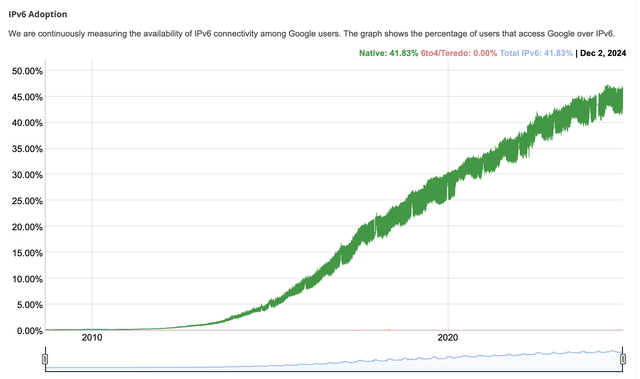
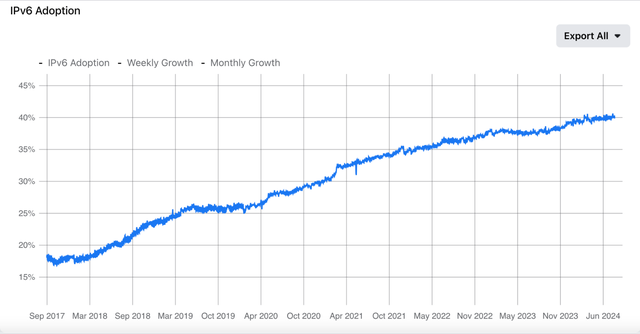
Routing table growth and optimisation
One reason early observers relied on web traffic metrics to gauge the health and well-being of the IPv6 Cat was the ease with which networks could advertise an IPv6 allocation in the routing tables without taking the necessary steps to ensure true penetration to the end user or properly optimise IPv6 routing. This led to misleading indications of growth, offering little insight into genuine deployment and usage.
However IPv6 deaggregation trends since 2017 demonstrate that network operators are actively fine-tuning IPv6 routes, signaling a level of operational maturity. This growth and optimisation suggest that the IPv6 Cat is not only alive but is also receiving the necessary support to survive and thrive from the network operator's side.
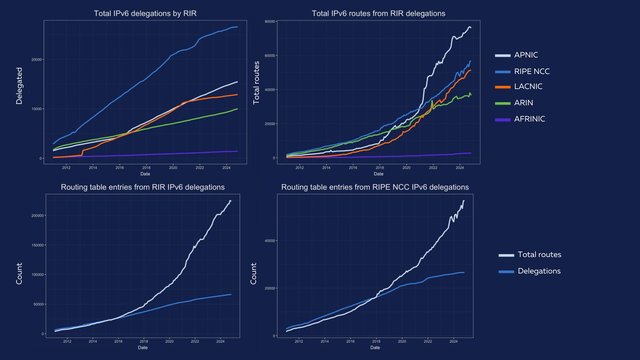
Moreover, the percentage of IPv6 addresses covered by Route Origin Authorization (ROA) is also growing up to the right, with ARIN (the Regional Internet Registry serving North America and parts of the Caribbean) seeing a significant increase in 2024 followed by LACNIC (the Regional Internet Registry serving Latin America and the Caribbean) and the RIPE NCC (the Regional Internet Registry serving Europe, the Middle East, and Central Asia).
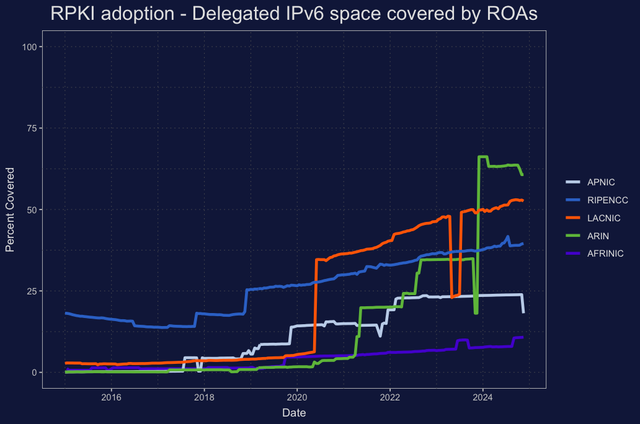
From the graphs, the IPv6 Cat is being advertised, optimised and cryptographically signed, all signs of its good health!
The right approach - incentives and collaboration
The mixed reality of IPv6 transition reflects a range of persistent challenges. Perceived high costs, inconsistent vendor support, and the lack of immediate return on investment hinder the transition for many. Smaller organisations, in particular, face significant barriers in upgrading infrastructure, training staff, and integrating IPv6 into their operations, often struggling to justify the necessary investments.
This difficulty is further compounded by the absence of direct, short-term financial returns from IPv6 deployment. Unlike other technological upgrades, IPv6 adoption does not generate measurable profits, making it less appealing for decision-makers focused on near-term gains. As a result, progress slows, with many organisations postponing or deprioritising the shift.
To overcome these challenges, a strategic approach combining economic and operational incentives with collaborative governance is essential. Governments and organisations must take proactive steps to create a more supportive environment for IPv6 adoption, including:
- Tax Rebates and Grants: Offering financial incentives to offset the costs of upgrading hardware, software, and training programs for IPv6 compatibility.
- Accountability for Vendors: Establishing contract requirements that mandate IPv6 readiness, with penalties for non-compliance. This ensures vendors actively support the transition and provide the necessary tools and services.
- Capacity-Building Initiatives: Supporting capacity-building programs through partnerships with technical organisations, universities, and training institutions to equip professionals with the skills needed for IPv6 deployment and management.
- Public Awareness Campaigns: Educating businesses, enterprises, and non-commercial edge network operators on the long-term benefits of IPv6 can play a pivotal role in raising awareness, driving demand, and fostering broader adoption.
By combining these measures, enterprises and network operators can address the barriers to IPv6 adoption while fostering collaboration between governments, industry leaders, and the technical community. This approach ensures that the transition to IPv6 remains inclusive, efficient, and aligned with the Internet’s principles of openness and innovation.
Permissionless innovation matters
IPv6 is more than just a technical upgrade - it is critical to preserving the Internet as an open platform for permissionless innovation. Across the globe, examples demonstrate how collaboration between governments, the technical community, and industry leaders can drive impactful adoption.
- In India, a mobile-first economy, IPv6 has enabled millions of new users to connect, showcasing the transformative potential of inclusive policies and collaborative strategies.
- Belgium’s world-leading penetration rates highlight how structured, technical community-led roadmaps can deliver remarkable results.
- Japan has advanced IPv6 adoption through government-led initiatives, deployment guidelines, industry collaboration, and public awareness campaigns like IPv6 summits. These collaborative strategies have also fostered innovation in IoT.
- Tech giants such as Google, Cloudflare, AWS, and Netflix have transitioned their platforms to IPv6, driving global uptake and setting an example for others.
- Even smaller enterprises, including startups in Africa and Lebanon and rural ISPs in Brazil, are leveraging IPv6 to overcome resource scarcity and expand services affordably.
These successes highlight that no single actor can drive IPv6 adoption alone; collaboration among governments, industry leaders, and technical communities is essential for ensuring the Internet’s resilience, scalability, and capacity for innovation.
Choose wisely
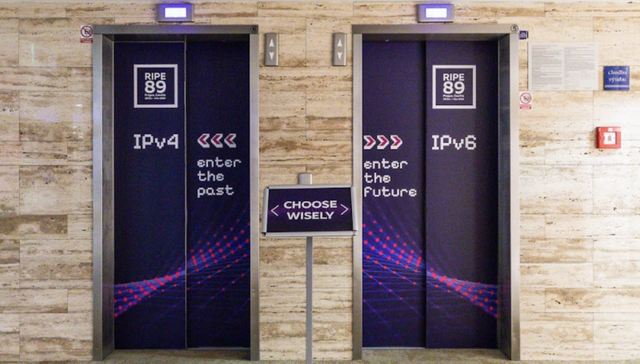
Choosing to write off IPv6 and its progress over the years is a comfortable decision for many. Continuing to run IPv4-based solutions offers them a sense of familiarity and stability for now, and perhaps even for the foreseeable future.
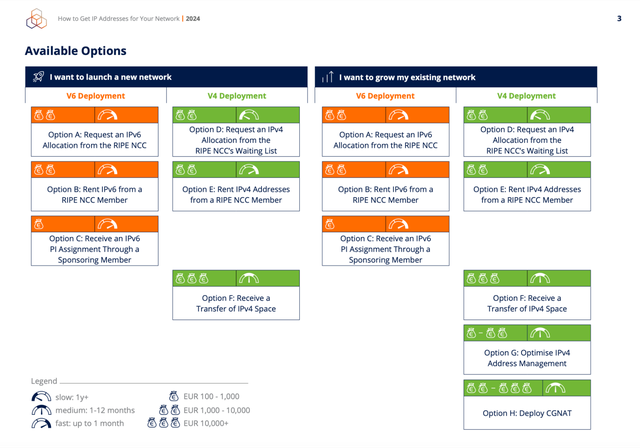
However, only by choosing to deploy IPv6, you open the box, revealing the true state of your IPv6 readiness and deal with what’s inside. By doing so you ensure the Internet grows, scales, and evolves beyond the constraints of IPv4. You open the door for others to innovate and redefine what is possible.
Whether you are ready to open the box or still evaluating your options, the RIPE NCC has prepared a guide on How to Get IP Addresses for Your Network to help you make the best decision for your organisation.





Comments 4
PAT •
Some of your proposed incentives would disadvantage operators that already deployed IPv6 and might make them wait for "Tax Rebates and Grants" when IPv7 or another significant development happens - ASPA. Instead, you completely ignore incentives related to the IPv4 Cat that is already outside the bag and confirmed dead, perhaps even close to beatification. As long as there is a market for dead IPv4 Cats, there will be a lot of incentives to make that market move. To overcome these challenges while still "combining economic and operational incentives and also collaborative governance", without the help of *GPT, the community needs to push for policies that show the community's desire to move on from the confirmed-dead IPv4 Cats. - Policies to stop allowing IPv4 dead Cat sales and transfers - Policies to enforce usage of fresh-out-of-recycling IPv4 dead Cats only for transition to the IPv6 Cats VAS systems have been shown to develop fast enough when there is a need for them, with enough pressure. For some (https://issuetracker.google.com/issues/36949085) there isn't enough pressure yet. - More pressure from the community through Public Awareness Campaigns All the excuses that, without permitting official transfers, these will go undocumented are just that: excuses. As with all situations involving money, some type of divine intervention is required to solve the problem.
Tim •
One of these days, some large company is going to switch a popular service to IPv6-only, and everyone will scramble to get on IPv6 to keep using it. Or a company will introduce a new IPv6-only feature that everyone will want to use. In a sense, Apple already did this, with the iPhone. It’s only desktops where IPv6 isn’t already completely dominant.
Andrew •
Transitioning to IPV6 typically requires either changing your network architecture or investing in researching alternatives. I and many other people like having NAT. It works really really well as a divider between my network and someone else's network. Yes, you can put a firewall in but that requires me to do work, NAT doesn't. Similarly, DHCP works well enough and I know how to use it. If we had IPv6 drop in replacements for both of these, I suspect most people would just bite the bullet.
Terry Manderson •
I reject this article, based on this: "However IPv6 deaggregation trends since 2017 demonstrate that network operators are actively fine-tuning IPv6 routes, signalling a level of operational maturity. This growth and optimisation suggest that the IPv6 Cat is not only alive but is also receiving the necessary support to survive and thrive from the network operator's side." This is a very poor understanding and appraisal of good IPv6 deployment, so much so that it just creates another IPv4-like routing swamp when organisations get allocations and then simply carve them up and advertise more specific routes for two reasons. 1. Because the space allocated to them is seen as limited so they then advertise a plethora of specifics into the Default Free Zone. And 2, Because the pain and cost of getting more IPv6 Address blocks from an RIR is beyond the tolerance of the requesting organisation! Ultimately what that does is increase the cost of the routing system for everyone across the Internet and repeat the errors we have already experienced for IPv4 BGP routing. Even more so if you are validating ROAs or reaching toward BGPSEC in the future. The promise for V6 was a plentiful addresses space, and a reduced routing table (yes, thus reduced ROAs but that came later). The praise in this article does the exact opposite. I suggest you go relearn historical conversations about the multiple reasons why IPv6 became an approved standard, and not what benefits it provides to the NCC. I further call into question the your criticism of IPv4 market effects. They are a normal free market effect and in fact most IPv4 costs are decreasing as a supply/demand. If you want cost regulation of IPv6 and IPv6 costs you are seem to be hinting on the ITU controls of the telephony system. Is that what you desire?